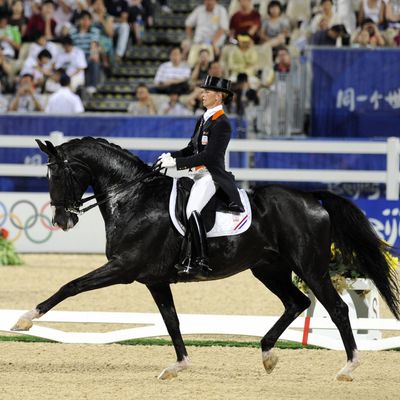
Not all Olympic events are as familiar as basketball or as straightforward as the 100-meter dash. But that’s no reason not to check something out during the Games. Throughout the Olympics, we’ll outline the basics of various sports for viewers who may not know what they’re looking at. Today: dressage, explained.
The equestrian discipline of dressage, an Olympic sport since 1912, has received considerably more attention than usual in 2012: As you might have heard, the horse Rafalca, being ridden by a member of the U.S. team, is partially owned by Ann Romney, wife of England’s least favorite Republican presidential candidate. Mitt swears he can’t be bothered to watch his wife’s horse compete, but if the idea of “horse ballet” contested by men in top hats and tails has piqued your interest (and there are nonpolitical reasons to be interested), here’s how this sport works.
Event Format
Olympic dressage events consist of three rounds, taking place on four different days spread out over a little more than a week. These rounds, called the Grand Prix, Grand Prix Special, and Grand Prix Freestyle, act as both the team and individual competition, and both male and female riders compete in the same event. The Grand Prix is a preliminary round for team and individual competition; the Grand Prix Special is a medal round for the team event and a second qualifier for the individual medals; and the Grand Prix Freestyle is the medal round for the individual event. There are 50 qualified riders for the individual event, and countries that have qualified three or the maximum four riders also compete in the team event.
Competition Area
Olympic dressage is contested in an open riding paddock 20 meters by 60 meters surrounded by five judges. Letters marking points on the edge of the paddock and a center line provide the basic outline for the different routes the horses make around the course.
Equipment, Horses, and Attire
Unlike thoroughbred racing horses, which are usually only a few years old at their fastest, world-class dressage horses are typically in their late-teens when they reach their peak, as it takes years of training for a horse to bond with its trainer and master the moves required. Training a world-class dressage horse is fantastically expensive, and the horses themselves are worth hundreds of thousands of dollars. The horses must be ridden with an English saddle. Rules for the dress of the riders are extremely strict. The Monopoly man get-up is not optional: top hats, tails and white gloves are mandated by international equestrian rules. Considering the expense of training a top-level dressage horse, it’s not exactly out of place, either.
How Someone Wins
In the Grand Prix and Grand Prix Special, all of the horses are put through a preset series of maneuvers called tests that last about six minutes without music. These tests are always the same and consist of 33 discrete sections in the Grand Prix and 36 in the Grand Prix Special. In these sections, the horses need to demonstrate varied speeds (walk, canter, and trot) and execute “passes” between specified points as well as moves like prancing in place and pirouettes. The performance of every horse is graded by section on scale from one to ten, with particularly difficult sections multiplied by two. The rider’s goal is to make the “test” appear effortless, moving as little as possible and communicating with the horse without audible commands. At the end of the test, the performance of the rider is rated one to ten. Final scores are calculated as a simple percentage of points earned for both the horse and rider; the highest scores are typically in the 70s.
The top seven teams in the Grand Prix, as well as the top eleven individuals not otherwise advancing (plus any other riders tied for eleventh) advance from the Grand Prix round to the Grand Prix Special. The Grand Prix Special is the final round of the team event: Teams are ranked by the cumulative scores of their top three riders over the first two rounds. The eighteen top preforming individuals in the Grand Prix Special, plus any ties for eighteenth, advance to the final round, though only three riders from a given country may advance. They compete in the Grand Prix Freestyle, which decides the individual medals. Unlike the first two rounds, in which every horse performs the same test, the horses perform a unique routine set to music with more room for creativity and difficulty than the preceding rounds. Some sections remain mandatory, but horses are also judged on the more holistic categories of rhythm, harmony, choreography, difficulty, and musical interpretation, which are weighted four times a typical section. Individual medals are awarded to riders based solely on the Freestyle score.
When To Watch
The Grand Prix takes place on Thursday and Friday, August 2 and 3. It begins at 6 a.m. New York time both days and will stream live on nbcolympics.com. It will also be broadcast both days on MSNBC on a tape delay at 12:30 p.m. (Politicos take note: Rafalca is competing on the first day.)
The Grand Prix Special takes place on Tuesday, August 7, starting at 5 a.m. New York time and and will stream live on nbcolympics.com. The final 45 minutes will be broadcast live on the NBC Sports Network, starting at 10:45 a.m.
The Grand Prix Freestyle takes place on Thursday, August 9, starting at 7 a.m. New York time and will stream live live on nbcolympics.com. The final two hours will be broadcast live on the NBC Sports Network, beginning at 9 a.m.
Previously:
The Casual Olympic Viewer’s Guide: Double Trap Shooting